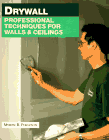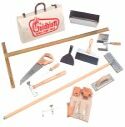DrywallAlso Known as Wallboard, Gypboard
What is it? Where does it come from? Where do I use it?

Very few people have ever heard of "hydrous calcium sulphate." And even fewer are aware that hydrous calcium sulphate - CaSO4.2H2O as chemists know it - is gypsum, the rock that nobody knows.
In addition to being found in the Egyptian pyramids, gypsum rock is referred to in the ancient cuneiform scripts of the Assyrians. Its use was probably developed by the Greeks, whose influence certainly remains in the name by which the rock is known.
They called it Gypsos, the source of our word "gypsum."
Gypsum is a rock that, like limestone, occurs naturally in many parts of the world, and like limestone, in an absolutely pure form it is white. However, the usual presence of darker impurities produces rock in varying shades of gray, brown, and even black. Since it normally is found close to the surface, gypsum can be mined or quarried easily.
The biggest part of the gypsum rock used in this country goes into wallboard for homes. Gypsum "boards" are formed by sandwiching a core of wet plaster between two sheets of heavy paper. When the core sets and is dried, the sandwich becomes a strong, rigid, fire-resistant building material. Fire-resistant because in its natural state, gypsum contains water, and when exposed to heat or flame, this water is released as steam, retarding heat transfer. Manufactured in unbelievable quantities on continuous machines almost a quarter mile in length, gypsum wallboard and lath, prefinished wallboard, and gypsum sheathing for use under exterior finishes are among the most important materials used in housing.
Here are a few other ways in which gypsum is seen during an average day.
First of all, there is toothpaste. Gypsum forms the basis for some of the well-known brands of toothpaste, and thereby helps to pay the salary of some of television's best-known entertainers.
Most of the fixtures in bathrooms are made of clay formed in a mold of gypsum plaster, and chances are that gypsum board is behind the wall tile.
At the breakfast table, plates, cups, and saucers are present which were shaped on or in a gypsum plaster mold, a mixture of plaster of paris and water. So were the sterling silver handles of knives, forks, and spoons.
On the way to work or school, people step on sidewalks made of Portland cement, which contains a percentage of gypsum to regulate the setting time.
Maybe their walk is covered with chalk marks from the game the children played the night before. But of course, they weren't made by chalk at all, but by a molded stick of, you guessed it, soft gypsum plaster.
Many streets and highways also contain their share of gypsum.
Doctors and dentists, too, use gypsum for everything from dental molds to splints.
Benjamin Franklin, the great experimenter, was one of the first to introduce it in this country when he used ground raw gypsum, called land plaster, on his farm.
Today, thousands of tons of land plaster are used in the U.S. each year.
(This information is from a booklet originally written by the late John C. Best, Vice President of National Gypsum Company).
FAQ's
What is the "R" Value for gypsum board?
For purposes of calculating "U" values, the "C" factor for 1" gypsum board is 1.2; Resistance "R" for 3/8" board is 0.32; for 1/2" board 0.45; for 5/8" board 0.56; and for 1" board 0.83.
What's the difference between "regular" and "type X" gypsum wallboard?
ASTM C 36 designates two types of gypsum wallboard, regular and type X.
Type X wallboard, which is typically required to achieve fire resistance ratings, is formulated by adding noncombustible fibers to the gypsum. These fibers help maintain the integrity of the core as shrinkage occurs providing greater resistance to heat transfer during fire exposure.
By ASTM definition, type X gypsum wallboard must provide: not less than a one hour fire resistance rating for 5/8" board or a 3/4 hour fire resistance rating for 1/2" board applied in a single layer, nailed on each face of load-bearing wood framing members, when tested in accordance with the requirements of ASTM E 119, Methods of Fire Test of Building Constructions and materials.
Additionally, the Gypsum Association requires 1/2" type X gypsum board to achieve a one hour fire resistance rating when applied to a floor ceiling system, as described by GA File Number FC 5410, in GA 600, the Gypsum Association Fire Resistance Design Manual.
What is Hi-Impact Wallboard?
Hi-Impact wallboard is a specially designed product consisting of 5/8" Fire-Shield Type X wallboard with a stronger core and face paper that is backed with Lexan polycarbonate film manufactured by GE Plastics.
What is "Green board"?
Green board is designed as an indoor tile backer board, & can be used as sheathing.
Gypsum sheathing has a moisture-resistant paper and a treated or non-treated gypsum core. Green board also has a moisture resistant paper and a treated core. Green board has a tapered edge while sheathing is a square edge product.
If you plan to attach vinyl or steel siding over the sheathing, there will be a dip at the taper; therefore, this application is unadvisable.
If the substrate is a stone or brick cavity wall, however, the application can work.
We strongly suggest using building felt over this type of sheathing.
It appears that for any high humidity application, Moisture-Guard® (green board) should be the preferred product. But that’s not necessarily the case.
For ceiling applications, green board requires extra support. According to Gypsum Association guidelines, green board in a ceiling application needs 12" o.c. support.
If supports are 16" o.c., 5/8" green board should be used. Why is this additional support needed? Moisture repellents, such as the asphalt and wax emulsions in the green board core formulation, act as lubricants. These lubricants cause the gypsum crystals to slip easily, resulting in board sag.
For bathroom ceiling applications, we recommend regular or Type X board. Simply apply a good quality sealer and two coats of latex based paint after installation.
Back to top
|
Drywall all About
Patching
Hanging-
Tools and Preparation
Hanging-
Procedure
Finishing-
Tools and preparation
Finishing Procedure-
Start to Finish
Texturing Large areas
Texture Patches
Removing Popcorn Texture
This paperback book contains drywall basics, the tools and materials you will need, and hanging and taping.
Has numerous black and white photographs and helpful illustrations. Repairing drywall, and how to apply special textured finishes.

Need Supplies?
Shopping
Directory
Planning a Big
Drywall job?

Everything to get you started is included in the Drywall Apprentice Tool Kit: T-square with lip, drywall saw, all around cutter, 10-inch taping knife, corner taping tool, 12-inch SS mud pan, checker head hammer, pole sander, 6-inch broad knife, 20-inch tool bag, hand sander, utility saw, and tool pouch.
On Sale Now
|


